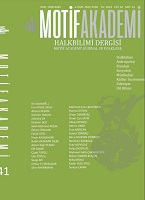LATİFE TEKİN’İN ORMANDA ÖLÜM YOKMUŞ ROMANININ ARKETİPLER AÇISINDAN İNCELENMESİ
AN EXAMINATION OF LATİFE TEKIN’S NOVEL ORMANDA ÖLÜM YOKMUŞ IN TERMS OF ARCETYPES
Author(s): Fatma Sönmez ÇakirSubject(s): Turkish Literature, Theory of Literature
Published by: Motif Halk Oyunları Eğitim ve Öğretim Vakfı
Keywords: Latife Tekin; Ormanda Ölüm Yokmuş; Archetype; Jung; Campbell;
Summary/Abstract: Archetypes, which C. G. Jung put forward and stated to belong to the collective unconscious, are common symbols that continue to be in the minds, dreams, literary works, cultures and so on of all humanity. Jung mentions some archetypes that are evident in the collective unconscious. These are the shadow, anima, animus, self, wise old man, mother, child and animal archetypes. J. Campbell adds the hero archetype (monommyth) to this. The hero archetype, which Campbell calls the monomyth, is also called the stage archetype. Monomyth returns to where they started after experiencing a three-stage adventure called departure, initiation and return. Of course, at the end of this journey, when they return, they cannot be expected to remain the same person. In this study, Latife Tekin's novel, Ormanda Ölüm Yokmuş, is evaluated in terms of these archetypes, which Jung and Campbell emphasize. Accordingly, Emin, the protagonist, is a modern monomyth; He sets out to escape the pain of love and therefore death. After meeting his young self in the forest, he matures, and upon his return from the forest to the city, he completes his return by removing all the leaves and stones he has collected at home in a chest. In the novel, the forest is the mother archetype, her friend Yasemin is the loving mother archetype, and her ex-wife, Gölge, is the scary mother archetype. Emin’s dog Yaşar is the shadow archetype, and his older friend Yurt is the old wise archetype. Emin's beloved woman Zümrüt and ex-wife, Gölge are anima archetypes. The man Emin meets in the forest, who is actually the younger version of himself, is the archetype of the self. The novel also includes tree archetypes, the number three archetype, sun and light archetypes, rebirth archetype and animal archetypes. From all these perspectives, it is seen that the novel has a symbolic language. We can say that Tekin’s use of these collective symbols in a language suitable for the ebb and flow between dream and reality caused the novel to move away from cliché fiction and to have a unique structure
Journal: Motif Akademi Halkbilimi Dergisi
- Issue Year: 16/2023
- Issue No: 41
- Page Range: 248-269
- Page Count: 22
- Language: Turkish

